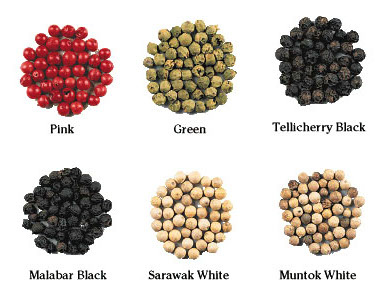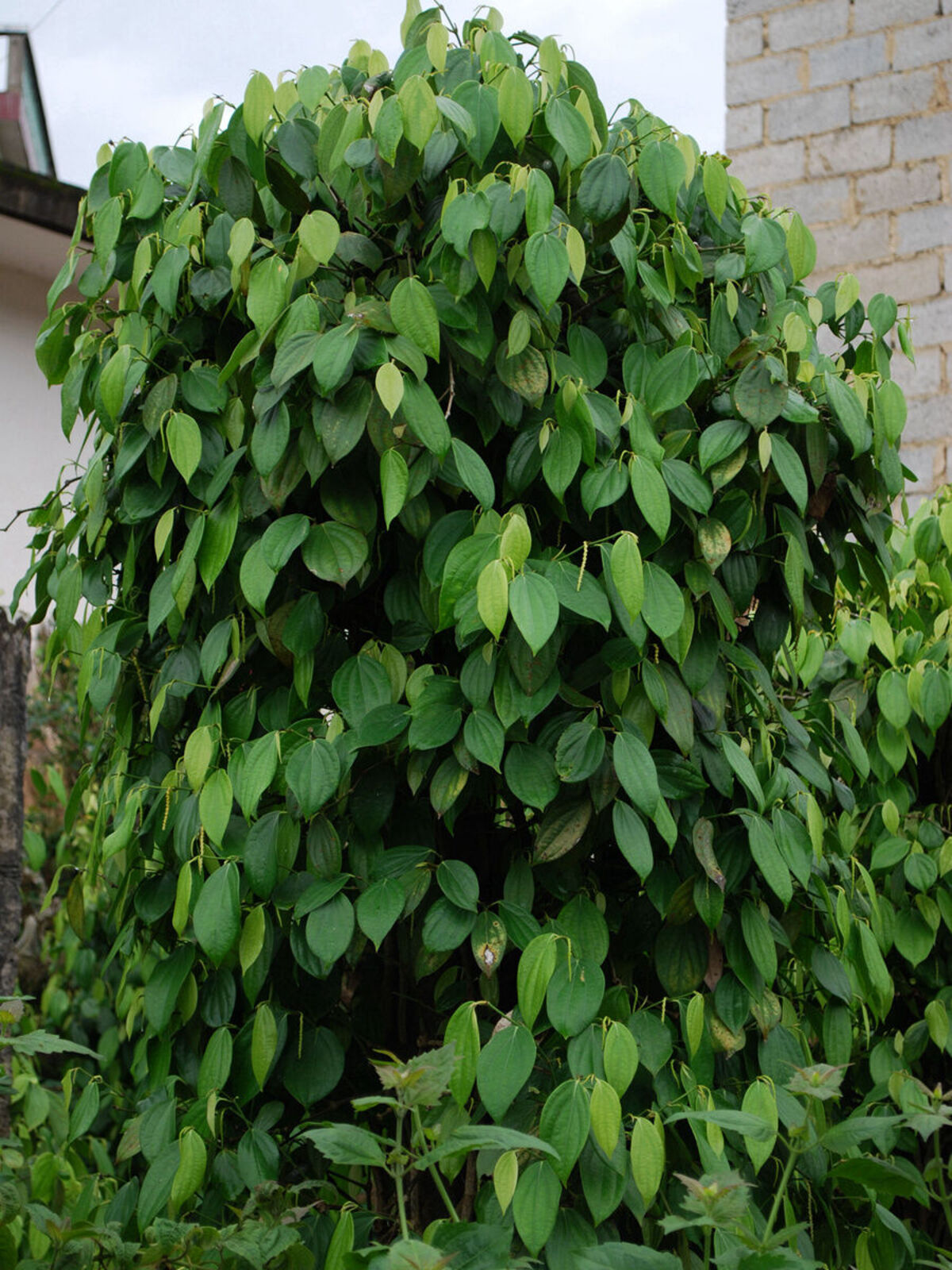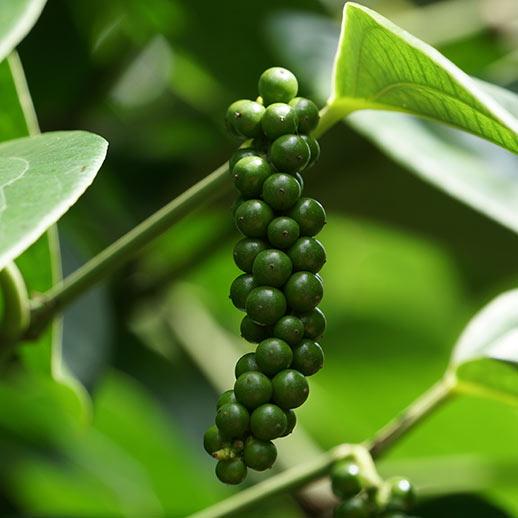Contents:
Common Names | Parts Usually Used | Plant(s) & Culture | Where Found | Medicinal Properties | Biochemical Information
Legends, Myths and Stories | Uses | Formulas or Dosages | Nutrient Content | How Sold | Warning | Resource Links
Scientific Names

- Piper nigrum
Common Names
- Black pepper
- Peppercorn
- King of spices
- Black gold
- Pippali (Sanskrit)
Parts Usually Used
The dried, unripe berries (peppercorns) of the vine. The peppercorns are harvested when they are almost ripe and then dried until they turn black and wrinkled.
Back to Top
Description of Plant(s) and Culture

Black pepper comes from a trailing vine plant that grows in tropical forests. The plant produces small white flowers and develops berries that change color depending on when they are harvested. To produce black pepper, the almost-ripe peppercorns are picked and left to dry until they shrivel and turn black.
The pepper vine is a perennial climbing plant that can grow up to 4 meters in height when supported by trees or poles. It thrives in hot, humid climates with well-drained soil and requires consistent moisture during the growing season.
Back to Top
Where Found
Black pepper is native to the tropical forests of the Malabar Coast in southwest India, particularly around the regions of Kerala, Goa, and Karnataka. Today, pepper cultivation has spread to many tropical regions worldwide.
Currently, about 39 percent of all black pepper production comes from Vietnam, which is the world’s largest producer. Indonesia produces about 15 percent, while India and Brazil each produce about 10 percent. Other producing countries include Malaysia, Sri Lanka, and various African nations.
Back to Top
Medicinal Properties

Black pepper has been shown to possess potent antioxidant, anti-inflammatory, antimicrobial, antibacterial, analgesic (pain-relieving), gastroprotective, neuroprotective, and potential anticancer properties. The spice also demonstrates prebiotic-like behavior and immune-supporting capabilities.
The primary bioactive compound responsible for these therapeutic effects is piperine, a natural alkaloid that gives black pepper its characteristic pungent taste and provides its health-boosting qualities. Piperine acts as a powerful antioxidant that helps reduce the risk of chronic illnesses such as atherosclerosis, cardiovascular disease, and neurological conditions.
Studies suggest that black pepper may help improve blood sugar control, reduce cholesterol levels, enhance brain function, support digestive health, and boost the absorption of essential nutrients and beneficial compounds from other foods and supplements.
Back to Top
Biochemical Information
The primary active ingredient in black pepper is piperine, a natural alkaloid that comprises 5-9% of the peppercorn. Piperine is responsible for black pepper’s pungent taste and most of its therapeutic properties.
Black pepper also contains other bioactive compounds including chavicine (another alkaloid), oleoresins, essential oils (limonene and beta-caryophyllene), flavonoids, and various phenolic compounds. These compounds work synergistically to provide black pepper’s antioxidant and anti-inflammatory effects.
Back to Top
Legends, Myths and Stories
Black pepper, derived from the Sanskrit word “pippali,” was once known as “black gold” due to its immense value in ancient trade. It has one of the longest histories as a sought-after spice, prized for its ability to flavor foods, act as a preservative, and add heat to dishes.
Black pepper was a cherished commodity in ancient Greece and Rome, and it reached even greater popularity during the Middle Ages and Renaissance. The spice was so valuable that it was sometimes used as currency, and the phrase “peppercorn rent” (meaning a very small payment) originated from using a single peppercorn as symbolic payment.
The search for black pepper and other spices drove much of the Age of Exploration, leading to the discovery of new trade routes and continents. The spice trade, particularly for black pepper, was instrumental in shaping world history and global commerce.
Back to Top
Uses
Black pepper is widely used both as a culinary spice and for its medicinal properties. In cooking, it enhances the flavor of meats, fish, vegetables, soups, and countless other dishes while serving as an excellent alternative to salt.
In traditional medicine systems, black pepper has been used for various therapeutic purposes:
- In Ayurvedic medicine: Used for treating menstrual disorders, ear-nose-throat conditions, digestive issues, and respiratory problems
- In Traditional Chinese Medicine: Combined with other herbs for treating blood stagnation and inflammatory diseases, plus pain relief and swelling reduction
- In folk medicine worldwide: Applied for digestive enhancement, immune support, pain relief, and treating various inflammatory conditions
- As a nutrient enhancer: Added to meals to increase the absorption of vitamins, minerals, and beneficial compounds like curcumin from turmeric
- For digestive health: Used to stimulate digestive enzymes and reduce gastrointestinal discomfort
- As an antioxidant supplement: Taken to help fight free radical damage and support overall health
- For respiratory support: Used traditionally to help with bronchitis and other breathing difficulties
Formulas or Dosages
For general health benefits and nutrient absorption enhancement: As little as 1/8 teaspoon of ground black pepper with meals can be beneficial.
For antioxidant effects: Studies have used 5-20 mg of piperine per dose in supplement form, which appears to be safe for most people.
For enhancing curcumin absorption: 20 mg of piperine taken with 2 grams of curcumin has been shown to increase curcumin availability by up to 2,000%.
For general culinary use: 1-2 tablespoons have been used in some studies, though this amount may be too much for most people to tolerate comfortably.
As a salt substitute: Use ground black pepper to taste when reducing sodium intake, as it provides flavor enhancement without the health risks associated with excessive salt consumption.
Back to Top
Nutrient Content
One teaspoon (2.3 grams) of ground black pepper contains:
- 6 calories
- 0.239 grams of protein
- 0 grams of fat
- 1.47 grams of carbohydrates
- 0.582 grams of fiber
- 0.015 grams of sugar
- 10.2 mg of calcium
- 0.223 mg of iron
- 3.93 mg of magnesium
- 3.63 mg of phosphorus
- 30.6 mg of potassium
- 0.46 mg of sodium
- 0.294 mg of manganese (13% daily value)
- 3.77 mcg of vitamin K (3% daily value)
- Various trace amounts of vitamin E, vitamin A, thiamine, riboflavin, vitamin B6, selenium, zinc, and chromium
How Sold
Black pepper is commercially available in several forms including whole black peppercorns, pre-ground black pepper powder, piperine extract supplements in capsules or tablets, essential oil for aromatherapy, and combination supplements with other herbs and spices.
For maximum health benefits, freshly ground pepper from whole peppercorns is recommended over pre-ground varieties, as this ensures purity and potency of the active compounds. Whole peppercorns maintain their potency longer when stored properly in a cool, dry place.
Back to Top
Warning
Black pepper is generally considered safe for most people when used in typical culinary amounts. However, consuming large quantities may cause digestive distress, including heartburn, indigestion, or burning sensations in the mouth and throat.
Black pepper, particularly through its active ingredient piperine, can significantly increase the absorption of certain medications, including antihistamines, which could lead to dangerously high levels of these drugs in the bloodstream. This effect can be beneficial for poorly absorbed medications but problematic for others.
People taking prescription medications should consult with their healthcare provider before significantly increasing black pepper intake or taking piperine supplements, as it may interact with various drugs and affect their absorption and effectiveness.
While no specific dietary guidelines exist for black pepper consumption, moderation is key. The typical amounts used in cooking are generally safe, but therapeutic doses should be used under professional guidance.
Back to Top
Resource Links
Healthline – 11 Science-Backed Health Benefits of Black Pepper
WebMD – Black Pepper: Health Benefits, Nutrition, and Uses
MedicalNewsToday – What are the health benefits of black pepper?
Cleveland Clinic – What Are the Health Benefits of Black Pepper?
National Library of Medicine – Black pepper and health claims: a comprehensive treatise
